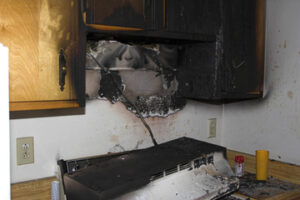Fire damage is one of the most serious types of property destruction. It can affect both the structure and the contents of a building.
Fire damage is typically caused by burning materials or exposing them to high temperatures. It can also be caused by the effects of smoke and corrosive substances. Click Here to learn more.
When a fire ravages your home or commercial building, the flames don’t just destroy items directly in their path. The smoke damage that lingers even after the fire is out can wreak havoc on your property and personal belongings as well. Smoke residue can taint walls, discolor surfaces, and cause odors that can linger for weeks after a fire. It’s important to have the proper fire damage restoration team in place to ensure you get your life back to normal as quickly as possible.
Depending on the type of fire, you may encounter wet or dry smoke damage. Wet smoke is the result of a slow-burning fire and can leave a sticky residue behind that’s difficult to clean. This type of smoke can also corrode metals and cause etching on glass. In addition, wet smoke can leave behind a strong odor that is nearly impossible to remove.
Dry smoke is the result of a high-temperature fire and leaves a powdery residue. It’s typically easier to clean than wet smoke, but it can still linger in the cracks of porous objects like wooden floors and wallpaper. It can also leave behind a smoky odor that’s easy to notice but not as strong as wet smoke odors.
It’s not uncommon for the water used to extinguish a fire to soak rugs, carpets, and fabrics. This leads to the growth of bacteria and other toxic organisms that can cause a variety of health issues for your family or employees. The toxins can be inhaled or absorbed through bare skin.
Protein residue is a type of smoke damage that’s caused by burned food and other proteins. It can linger for weeks after a fire and permanently discolor painted or varnished surfaces. The smell is often the first sign of this type of smoke damage. If left untreated, it can linger for months and even eat through drywall. This type of smoke damage is commonly seen behind drapes and on venetian blinds. This is due to the temperature difference between these areas and the rest of the room, which causes them to attract more smoke residue.
Water Damage
Almost as damaging as flames is the water damage that occurs during and after a fire. Water damage from building sprinklers and water used by the fire department to extinguish the fire can wreak havoc on a property, both in terms of structural degradation and equipment losses.
Depending on the type of fire, different types of damage may occur. For example, electrical fires create different issues than combustible material fires. Additionally, different fires burn at different temperatures. This is why it’s important to work with a company that understands fire damage, including the different kinds of fire and the effect it has on different materials and structures.
When a fire happens, your first priority is getting yourself and your family to safety. Once you’ve done that, you’ll want to survey the damage and determine what needs to be done to get your home or business back to normal. Unfortunately, a lot of damage is not caused by the actual fire and may be hidden until the aftermath.
One of the most common problems is water damage. Thousands of gallons of water are often needed to put out a fire, which can cause a great deal of destruction. Not only does it harm the structure of the home, but it can also damage personal belongings and even the surrounding environment.
Water damage after a fire can lead to mold growth, which is bad for the health of the residents and workers who live in or visit the space. It can cause respiratory issues, headaches, and allergies. If the issue is not addressed immediately, it can worsen and result in costly repair bills.
If your property sustains fire damage, it’s essential to have professional restoration services perform the necessary cleaning and repair work. They’ll assess the full extent of the damage, ensuring that all areas of the structure are repaired and restored. They’ll work closely with your insurance company to ensure that all damaged items are covered. They’ll also make sure that any issues are documented in order to ensure proper compensation from your insurer. This way, you’ll be able to return to your home or business with confidence that it’s safe and secure for all who use it.
Fuel Damage
A fire can have a wide-ranging impact on people and communities. This includes the direct destruction caused by the fire itself as well as the long-term effects of smoke and soot damage. Fortunately, with proper prevention and response, the effects of a fire can be greatly reduced.
The primary threat to a building during a fire is the fuel, or combustible material. This can include walls, carpets, framing, roofs, and furniture. Typically, items that have been burned during a fire cannot be salvaged and must be removed from the structure. This includes wood and metal, as well as any other combustible materials.
When the fuel in a building has been consumed, there is no longer a threat to the structure. However, this does not mean that a building is safe to live in. There may still be structural damage that is not visible, or the structure may be weakened by the heat of the fire. This can lead to the collapse or instability of the structure, which poses a serious safety risk for anyone inside the building.
After a fire, it is important to create a damage assessment report for your home or business. This will help to determine the level of fire damage and can be used to develop a plan for repair or reconstruction. A qualified professional should perform this damage assessment and evaluate the structure for any potential risks, such as structural instability, electrical hazards, or lingering smoke and soot.
Soot from a fire is acidic and can cause etching in glass, metals, and other surfaces. This damage is exacerbated when it is touched with bare hands, which mix the oils from your fingers with the acidic soot. Therefore, it is important to always wear gloves when working with any impacted items.
The most severe form of fire damage is caused by the burning of vegetation. This is often called conflagration, and it can destroy large areas of a forest. This type of fire damage is very difficult to assess, as it can be difficult to survey the site. In the past, post-forest fire damage assessments were performed by manual labor, which was often time-consuming and inaccurate. In modern times, aerial and telemetric technology are used to record high-resolution images of the affected area. This data is then compiled into a relational database to calculate the volume of damage and its value.
Structural Damage
Depending on the severity of the fire, it may have caused structural damage to the property. Structural damage can include any materials, equipment, or infrastructure that was burned, melted, scorched, or otherwise affected by the flames and heat from the fire.
A good fire damage restoration company can assess the condition of a structure and determine whether it can be safely returned to use. The process involves cleaning smoke, odor, and soot and working to remove any disturbed hazards like lead and asbestos.
Structural repairs are often needed as a result of the fire itself or water damage. Sometimes, the damage is caused by the water that was used to extinguish the fire, and it can also be due to pressure from the firefighters’ hoses causing the pipes to burst. When these issues are left untreated, they can cause further problems and potentially threaten the safety of a home or commercial building.
If you experience structural damage, it is important to hire a fire damage restoration company right away. They can help you with a variety of different services, including repairing and replacing the damaged material, restoring items that have been lost in the fire, and returning your home or business to its pre-fire condition.
If you have suffered structural damage as a result of a fire, it is important to remember that you should never return to the property until you have been given the all-clear by authorities. This can include the fire department, a fire investigator, or even your insurance company. Always look for color-coded tape over doors or windows and follow their instructions regarding when it is safe to enter. It is a good idea to leave children with family members or a friend when doing your first inspection of the damage, as seeing the destruction can upset them and have long-term effects. If you notice that a door is jammed or not opening as it normally does, this could be a sign of serious structural damage. Don’t try to force open the door, as it could be providing support to the rest of the structure.
